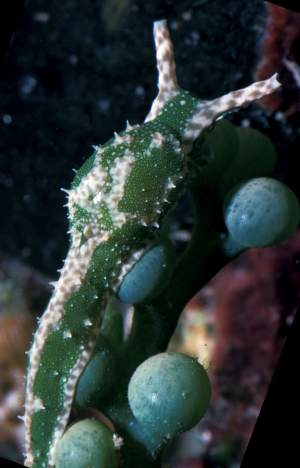
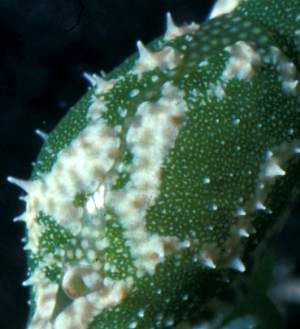
Oxynoe antillarum
Morch, 1863
Order: SACOGLOSSA
Superfamily: OXYNOOIDEA
Family: Oxynoidae
DISTRIBUTION
Tropical and subtropical west Atlantic from Florida to northern Brazil.
PHOTO
Laughing Bird Cay, Belize. Photo: Jeff Hamann.
Animal green, often with translucent white spots all over. There is a characteristic pattern of mottled white pigmentation. The rhinophores are mottled white and there is a band of this colour extending along each side of the head from the base of each rhinophore. A similar coloured band runs around the edge of the parapodia, and along the edge of the foot, and forms a median line down the foot, behind the parapodia, to the posterior tip. The parapodia and foor have scattered papillae which are often pigmented white.
Reference:
• Morch, O.A.L. (1863): Revision des especes du genre Oxynoe Rafinesque, et Lobiger Krohn. Journal de Conchyliologie, 11: 43-48.
Rudman, W.B., 2000 (October 5) Oxynoe antillarum Morch, 1863. [In] Sea Slug Forum. Australian Museum, Sydney. Available from http://www.seaslugforum.net/find/oxynanti
Related messages
Mating Oxynoe antillarum
September 1, 2009
From: Lureen Ferretti
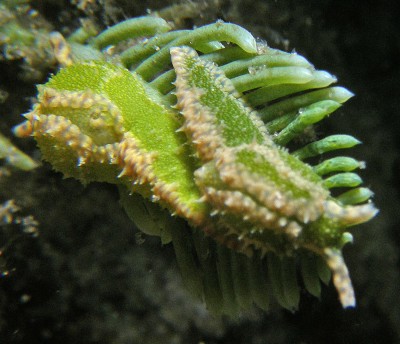
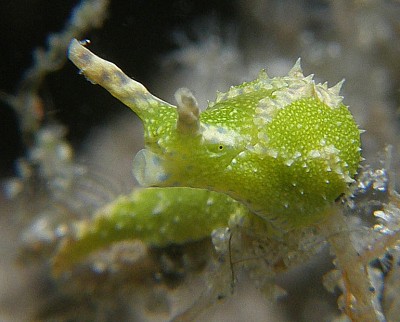
Concerning message #22617:
Hi Bill,
This is Lureen again. I'm excited, I have more than one photo to submit. I'll check my other nudi photos to see if I have anything else to offer.
Locality: Lake Worth Lagoon, Palm Beach, 8 feet, Florida, United States, inlet area of the Atlantic Ocean, 18 August 2009, inlet. Length: 1 inch. Photographer: Lureen Ferretti.
Lureen
enchantedpath@comcast.net
Ferretti, L., 2009 (Sep 1) Mating Oxynoe antillarum. [Message in] Sea Slug Forum. Australian Museum, Sydney. Available from http://www.seaslugforum.net/find/22618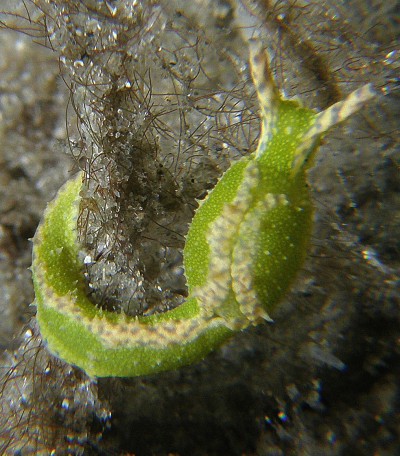
Dear Lureen,
Thanks for these photos of the Caribbean Oxynoe. You mention in your heading that the two animals were mating, although I can't see any sign of it in your top photo. Perhaps they had finished when you took this photo?
More offerings are always welcome
Best wishes,
Bill Rudman
Oxynoe antillarum from Jamaica
October 14, 2003
From: Ross W. Gundersen
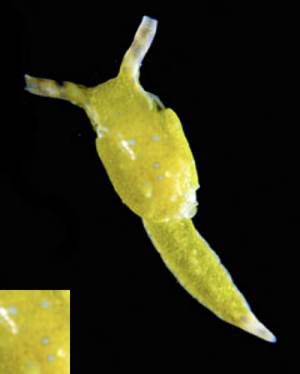
Dear Bill:
Here is another sea slug from Jamaica. As I said in my first message, all specimens were collected from St. Ann's Bay, Jamaica, West Indies. Photo: R. Gundersen.
Here is Oxynoe antillarum. Immature specimen found on Caulerpa at 5 m depth.
Best wishes,
Ross
ross.gundersen@uwp.edu
Gundersen, R.W., 2003 (Oct 14) Oxynoe antillarum from Jamaica. [Message in] Sea Slug Forum. Australian Museum, Sydney. Available from http://www.seaslugforum.net/find/11128Thanks Ross,
I've included an an enlarged section to show the blue spots present on the mantle, beneath the transparent shell, in this juvenile
Best wishes
Bill Rudman
Oxynoe antillarum from Belize
October 19, 2002
From: Dave Behrens

Bill:
Here is another shot Jeff Hamann and I took in Belize at Laughing Bird Cay, Belize. This is a spectacular example of O. antillarum, which was common on the Caulerpa.
Dave Behrens
dave@seachallengers.com
Behrens, D., 2002 (Oct 19) Oxynoe antillarum from Belize. [Message in] Sea Slug Forum. Australian Museum, Sydney. Available from http://www.seaslugforum.net/find/8203
Thanks Dave,
It's nice to get a good photo of this species. I have included a close-up of the shell-parapodia region alongside so we can see the colour pattern more clearly. The pattern of mottled white bands are certainly much more distinctive than in the common Indo-West Pacific species, Oxynoe viridis, although there are traces of a similar pattern in that species.
Bill Rudman
Unknown stowaway on Caulerpa
September 3, 2002
From: James Stein
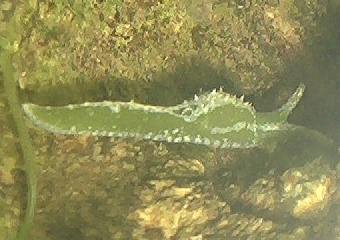
I recently purchased some Caulerpa from a marine store in Tampa, Florida [USA]. I have no idea where the algae came from but I would suspect off the coast of Tampa somewhere. I was pleasently suprised to find one of these critters in my tank after putting the algae in it. Much to my suprise I've counted now a total of 5 of them and they are literally covering every surface they can find with spirals of green eggs. They are all about 1 inch to 1 1/2 inches in length now and have a habit of entwining themselves in groups of 3 or more. I'm interested in finding out exactly what they are. They aren't particularly pretty or colorful but are still quite interesting to watch. Any help would be greatly appreciated.
James Stein
james_c_stein@hotmail.com
Stein, J., 2002 (Sep 3) Unknown stowaway on Caulerpa. [Message in] Sea Slug Forum. Australian Museum, Sydney. Available from http://www.seaslugforum.net/find/7875Dear James,
Your little animal is the Caribbean species Oxynoe antillarum. It feeds on Caulerpa, so that is obviously how it arrived in your aquarium. If you can take a photo of the egg masses it would be a nice addition to the Forum.
They have a transparent shell which is hidden between the two flaps of skin [parapodia] behind the head. Oxynoe is a sacoglossan sea slug, a group which includes the shell-less Elysia crispata which you may be familar with. All sacoglossans feed by stabbing a hole through the cell wall of the algae that they feed on, and then sucking out the cell contents.
Best wishes,
Bill Rudman
Lime green sea slug
April 16, 2002
From: Don Pelino
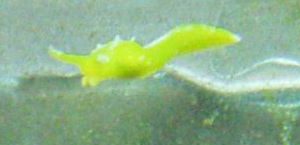
I found this sea slug in my aquarium's refugium. it's about 1/4" to 1/2" long, vivid bright lime green and looks to have either a white stripe or white markings on the back. It also appears to have a tail/foot that is somewhat flat or blade shaped although that could just look that way due to muscular movement. I'm guessing it came from Live Rock or Caulerpa from the Gulf of Mexico on the Florida coast as all of the LR in the refugium is Florida aquaculture and the Caulerpa came from Florida as well. Some from the Tampa, Florida area and some from Dade City, Florida. I don't believe any of it came from the Atlantic coast of Florida.
Don Pelino
Cyberchef_@hotmail.com
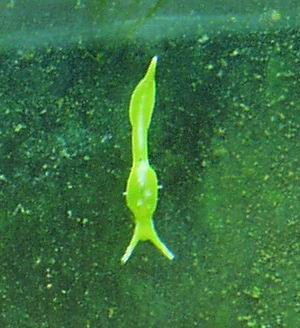
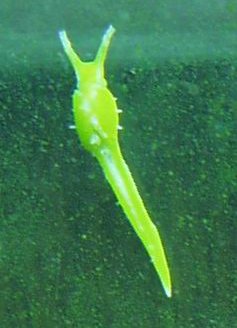
Dear Don,
Your slug is a species of Oxynoe, and if it is from Florida then I guess it is Oxynoe antillarum. This species feeds on Caulerpa so as you guessed, this is the most likely way it got into your aquarium. If you don't mind it eating a bit of your Caulerpa, it would be an interesting addition to your aquarium. Have a look at my comments on Matt's message for some more information on the species.
Best wishes,
Bill Rudman
This guy suddenly appeared in my aquarium!
October 7, 2000
From: Matt Galvin
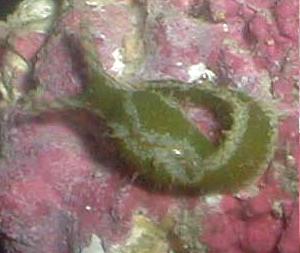
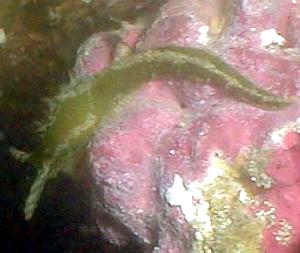
Hi everyone!
Am hoping somebody can help me identify this guy. I was watching my aquarium one day and noticed him moving around on the glass. He's about an inch long, and I've since seen him on the glass and rockwork. I've also seen several smaller ones (< 1 cm) since then.
If someone knows what he is, can you also let me know anything special about him? Such as what does he eat, what his survival chance is, etc?
Hopefully someone can help!
tia!...
Matt
luminary@liquidchaos.net
Galvin, M., 2000 (Oct 7) This guy suddenly appeared in my aquarium!. [Message in] Sea Slug Forum. Australian Museum, Sydney. Available from http://www.seaslugforum.net/find/3120Dear Matt,
This is a sacoglossan sea slug of the genus Oxynoe. I am pretty sure it is Oxynoe antillarum Morch 1863 which is found in the tropical and subtropical western Atlantic from Florida to northern Brazil. It feeds on the bright green sea weed Caulerpa. I have no idea where you live or where your aquarium animals came from but if you have added rocks or green weed from the Caribbean recently, that is the most likely place your Oxynoe came from.
What can I tell you about them. Firstly you should stop calling them 'he', because like all sea slugs they are hermaphrodites with a full set of male and female organs. They are sacoglossan sea slugs, not nudibranchs. Have a look at the animals in the Species List under the ORDER SACOGLOSSA. If you look at some of these you will see they range from snail-like animals with an external shell to bright colourful slugs. They are all herbivores, and they all feed by piercing the cell walls of the sea weeds, with a sharp dagger-like tooth, and sucking out the cell sap.
Your Oxynoe has a fragile colourless shell which is no longer strong enough to protect it from predators. If you irritate this animal, or for that matter most sacoglossans, they will exude a thick milky white secretion from their skin. This contains unpleasant chemicals, some of which are thought to be derived from the plants they feed on. This secretion deters predators.
If you keep some Caulerpa in your aquarium, your slugs will probably live quite happily for some months.
Best wishes,
Bill Rudman.
